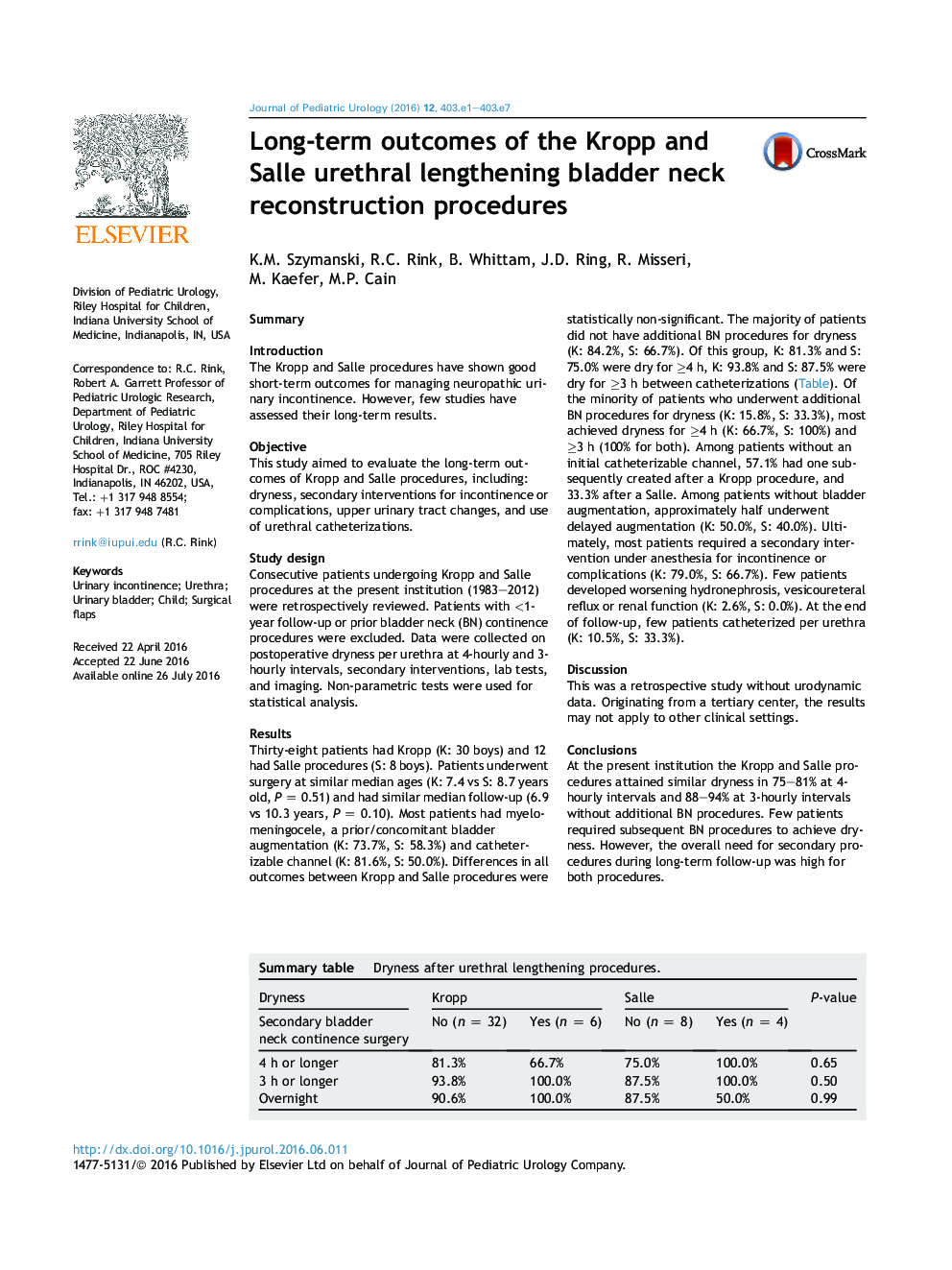| کد مقاله | کد نشریه | سال انتشار | مقاله انگلیسی | نسخه تمام متن |
|---|---|---|---|---|
| 5718727 | 1411256 | 2016 | 7 صفحه PDF | دانلود رایگان |

SummaryIntroductionThe Kropp and Salle procedures have shown good short-term outcomes for managing neuropathic urinary incontinence. However, few studies have assessed their long-term results.ObjectiveThis study aimed to evaluate the long-term outcomes of Kropp and Salle procedures, including: dryness, secondary interventions for incontinence or complications, upper urinary tract changes, and use of urethral catheterizations.Study designConsecutive patients undergoing Kropp and Salle procedures at the present institution (1983-2012) were retrospectively reviewed. Patients with <1-year follow-up or prior bladder neck (BN) continence procedures were excluded. Data were collected on postoperative dryness per urethra at 4-hourly and 3-hourly intervals, secondary interventions, lab tests, and imaging. Non-parametric tests were used for statistical analysis.ResultsThirty-eight patients had Kropp (K: 30 boys) and 12 had Salle procedures (S: 8 boys). Patients underwent surgery at similar median ages (K: 7.4 vs S: 8.7 years old, P = 0.51) and had similar median follow-up (6.9 vs 10.3 years, P = 0.10). Most patients had myelomeningocele, a prior/concomitant bladder augmentation (K: 73.7%, S: 58.3%) and catheterizable channel (K: 81.6%, S: 50.0%). Differences in all outcomes between Kropp and Salle procedures were statistically non-significant. The majority of patients did not have additional BN procedures for dryness (K: 84.2%, S: 66.7%). Of this group, K: 81.3% and S: 75.0% were dry for â¥4 h, K: 93.8% and S: 87.5% were dry for â¥3 h between catheterizations (Table). Of the minority of patients who underwent additional BN procedures for dryness (K: 15.8%, S: 33.3%), most achieved dryness for â¥4 h (K: 66.7%, S: 100%) and â¥3 h (100% for both). Among patients without an initial catheterizable channel, 57.1% had one subsequently created after a Kropp procedure, and 33.3% after a Salle. Among patients without bladder augmentation, approximately half underwent delayed augmentation (K: 50.0%, S: 40.0%). Ultimately, most patients required a secondary intervention under anesthesia for incontinence or complications (K: 79.0%, S: 66.7%). Few patients developed worsening hydronephrosis, vesicoureteral reflux or renal function (K: 2.6%, S: 0.0%). At the end of follow-up, few patients catheterized per urethra (K: 10.5%, S: 33.3%).DiscussionThis was a retrospective study without urodynamic data. Originating from a tertiary center, the results may not apply to other clinical settings.ConclusionsAt the present institution the Kropp and Salle procedures attained similar dryness in 75-81% at 4-hourly intervals and 88-94% at 3-hourly intervals without additional BN procedures. Few patients required subsequent BN procedures to achieve dryness. However, the overall need for secondary procedures during long-term follow-up was high for both procedures.Summary table. Dryness after urethral lengthening procedures.DrynessKroppSalleP-valueSecondary bladder neck continence surgeryNo (n = 32)Yes (n = 6)No (n = 8)Yes (n = 4)4 h or longer81.3%66.7%75.0%100.0%0.653 h or longer93.8%100.0%87.5%100.0%0.50Overnight90.6%100.0%87.5%50.0%0.99
Journal: Journal of Pediatric Urology - Volume 12, Issue 6, December 2016, Pages 403.e1-403.e7